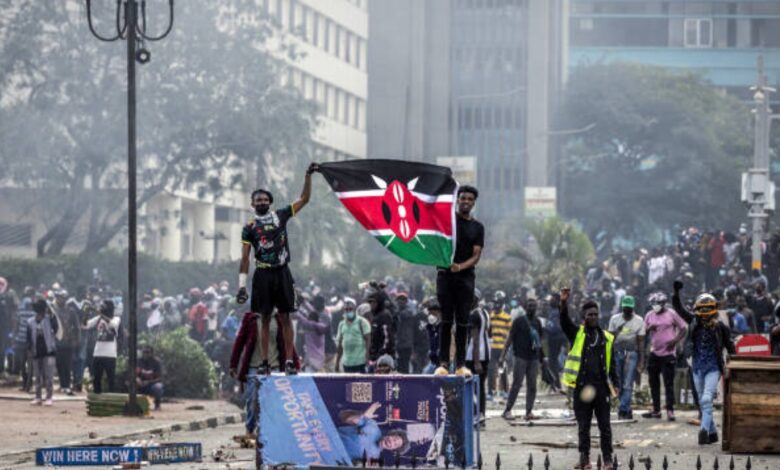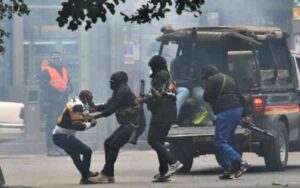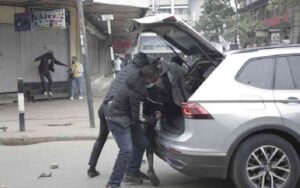How Gen Z Protesters were Abducted, Extorted in Chilling Encounters with Armed, Hooded Men
Under the visible layers of frustration and resistance, lay even more sinister stories of abductions and disappearances that have stirred a growing fear across families and the country

Nairobi, Nov 13 – They arrived in unmarked cars with faces concealed behind masks. In broad daylight, without a word, they would snatch young Kenyans off the streets, in their estates or homes, and vanish with them. What followed were hours of terror, confusion, and desperate pleas for survival. These individuals were not criminals or rebels hiding in Nairobi’s dark alleys—they were ordinary citizens, mostly Gen Z protesters, expressing dissent against the government’s tax increase and demanding accountability.
But behind the thin veneer of this “law enforcement”, a darker, more sinister operation was unfolding—one that preyed not only on the bodies but the wallets of these individuals. Between September and October, we interviewed 32 victims of extrajudicial abductions and forced arrests, alongside three police officers, who revealed horrifying experiences within the force. Chilling accounts have emerged of how rogue officers from specialized units, including the Directorate of Criminal Investigations (DCI) and the National Intelligence Service (NIS), have turned abduction into a profitable racket, using the law as a tool for extortion rather than justice.
In the wake of the June to August countrywide protests, largely sparked by opposition to the then government’s proposed Finance Bill 2024, which aimed to raise taxes, many Kenyans voiced frustration as they were already struggling to make ends meet. For the masses taking to the streets, this was not just about a single piece of tax legislation—it was a defiant stand against a system they felt had betrayed them and was persistently pushing them to the brink.

Corruption and Brutality: The Hidden Forces Behind Abductions
Anger had been simmering for months, fueled by the soaring cost of living, compounded by looting of public funds and rampant corruption. Government officials displayed opulence even as the national debt grew, burdening future generations. Inflation was squeezing household budgets to the breaking point, and poor governance had eroded faith in President William Ruto’s administration. The government’s brutal response to the protests, marked by forced abductions, arbitrary arrests, and the use of brutal violence against protesters, only fueled discontent, creating a pervasive atmosphere of fear and more anger in the public.
Victims, aged between 24 and 27, both men and women, recounted harrowing experiences of being abducted in unmarked vehicles, held incommunicado, and coerced into paying bribes for their release. Some re-appeared days later, tortured and traumatized, with stories of terrifying ordeals. Others were found dead, strangled, or riddled with gunshot wounds. The wave of abduction and disappearances continues, painting a stark picture of a state apparatus accused of targeting its own citizens, using brutal force to silence dissent and instill disproportionate fear.
Victims, survivors, and police officers who spoke to us revealed that behind these abductions and disappearances is a shadowy force within the police’s special units, operating in the grey area between law enforcement and organized crime. “These are no ordinary arrests; they are meticulously planned abductions aimed at intimidating the protest movement, instilling fear while lining the pockets of those carrying them out,” said a police officer in confidence.
The officers we spoke to confirmed the existence of rogue members within their ranks who they said were exploiting the government’s intolerance of dissent to operate outside the law, arresting and extorting money from abductees or those in their custody. “I believe most of these officers are simply taking advantage of the prevailing situation. Abductions have instilled a great deal of fear in people,” another officer added. The officers also revealed that some of these “traumatic arrests or abductions” are happening without formal authorization from higher-ups, which suggests a serious misuse of power within a section of police service under the guise of law enforcement.
A DCI officer, also speaking anonymously, shared that although officers are increasingly hesitant to join specialized units, known as “crack units” especially after the Special Service Unit’s disbandment in October 2022 and subsequent legal actions against its members. “There are now two specialized operations units—one at DCI HQ and another within the NIS in Nairobi,” he said. He said that while orders may come from top levels, including from the State House, this isn’t always stated directly when assigning duties by their seniors. He pointed to the possibility that a senior State House official could be coordinating some of the abductions, possibly carried out by the NIS.

Fear and Extortion: The Shadowy Network Within the Police Force
All the victims and survivors’ accounts were chillingly similar. They spoke of being grabbed without warning by people in masks, dragged into unmarked cars with fake plates, and whisked away as people watched helplessly in fear. “I had just arrived in town as we gathered to start our protest when they [police officers] pulled up beside me,” said 24-year-old Benson, a university student who participated in the June 25 protests. “Before I could even process what was happening, they shoved me into the backseat of a vehicle. There were no badges, no uniforms—just men in masks brandishing pistols with cold, threatening eyes.”
Once inside these vehicles, the horror deepened. Victims described being subjected to grueling interrogations about who was leading protests and funding them. But these weren’t the actions of officers seeking truth. Instead, the alleged officers used fear as leverage, deliberately prolonging the ordeal to wear down their abductees emotionally. “They kept asking who was paying us to be on the streets, but I could tell they didn’t care about the answers. They just wanted us to break,” said Martin, another victim of abduction on June 25.
And breaking, many of them did—but not in the way the officers hoped. As the hours dragged on, and abductees began to feel increasingly helpless, the true intent of their abductors became clear. “At some point, after being driven around the city and later taken to an abandoned building where many other protesters were being held, some visibly beaten, one of the officers manning the place said without blushing, ‘You know, there’s a way out of this,'” recounted Benson. “That’s when he told us to show them our Mpesa balance or call family members for money. Another officer said if we don’t have enough cash, they would disappear us forever.”
Some family members, gripped by fear for the lives of their loved ones, would often wire large sums of money in the hope of securing their sons’ and daughters’ release. “My son called and said that he has been arrested for participating in an illegal protest and that police were demanding 10,000 shillings for his freedom,” said one tearful parent. “We had to borrow from friends and neighbors. We were just scared he wouldn’t come back.”
Nearly two months after the protests, many victims and their families were still too frightened to speak openly, even refusing to show their faces during our interviews. Those who did agree to share their experiences insisted on anonymity, fearing severe repercussions from the police. Peter, a victim from Baba Dogo in Mathare, described how the police had taken his phone number and warned him they were monitoring his communications. “If I said anything, they would come for me. They know where I live,” he recalled, pointing to visible scars from beatings as evidence of his ordeal.

Kenneth, 24, recounted his own harrowing experience after the June 25 protest: “I was heading home with friends when an unmarked car pulled up near Jogoo Road. Four men jumped out and chased us. My friends managed to escape, but I was caught. They threw me into a police van and drove me to what I believe was around the Industrial area. They interrogated me about who had organized the protests and then began discussing money. I felt completely helpless at one of the construction sites as they threatened to make me disappear forever if I didn’t cooperate. So, I cooperated—with 2,000 shillings, the money I had meant for my sick mum’s medicine the next day.”
Tom, 27, from Nairobi, described his abduction: “They picked me up off the street and threw me into a car. We drove around, picking up other protesters, and then were taken to a place that wasn’t a police station. I still don’t know where we ended up. They locked us inside, and one by one, we were taken out for ‘questioning.’ They asked about my friends and who was funding us to protest. They threatened me with violence if I didn’t hand over cash. The police, who were supposed to protect us, were the ones doing this.”
A 25-year-old woman from Kahawa shared a similar ordeal: “We were peacefully protesting when I was suddenly shoved into a car. They took me to an unknown location and interrogated me, asking why a ‘beautiful young girl like me’ was on the streets. They even made me show my Mpesa transactions to determine who was funding us. I was terrified for my life. Eventually, they forced me to call my family for money while they stood over me, insisting they would keep me if I didn’t cooperate. I feared for the worst, especially since they were all men,” she explained. She eventually gave 5,000 shillings for her release.
The abductions didn’t just occur in Nairobi. A man near in recounted his experience: “They grabbed me near Mombasa’s postal office and demanded to know about my parents and what they did for a living. They said they had been looking for me as one of the organizers of the Gen Z protest, which wasn’t true. I was terrified, thinking I would never see my family again. They made me withdraw 3,500 shillings from my M-Pesa, then drove for hours, picking up and dropping off other people. Eventually, they abandoned me on the road to Mtwapa and warned me of serious consequences if I returned to the streets.”
Victims from Kisumu, Nakuru, and other areas shared similar terrifying stories of police abductions and extortion. In Kisumu, Ochieng and his friend were forcibly taken into an unmarked vehicle, where they were threatened and extorted. Ochieng was forced to withdraw 2,000 shillings from Mpesa. In Nakuru, victims described being extorted for amounts ranging from 2,000 to 6,000 shillings. These accounts reveal a chilling pattern of widespread fear and coercion.

Human Rights Watch’s latest report states that nearly all detainees said police denied them food and water, and families were asked to pay between 3,000 and 10,000 Kenyan shillings in bribes for their release. The report, which interviewed 75 people from Mathare, Kibera, Rongai, Mukuru Kwa Njenga, and Githurai neighborhoods, included former abductees, witnesses, journalists, parliamentary staff, relatives of the missing, protesters, human rights activists, and police officers.
Prominent activists, while still facing rough treatment and unrecorded detentions, reported fewer extortion attempts, likely because law enforcement officers feared being exposed. For example, human rights activist Hellen Adhiambo was detained for five hours at Ahero police station over accusations of mobilizing protests, but no bribes were demanded.
Victims consistently described the entire process as methodical—abductions, interrogations, and ransom demands played out with chilling precision. The most haunting fear for many was not the threat of jail, but the fear of disappearing forever, swallowed by a system that they said no longer interested in justice, but in greed and power.
According to Kenya National Commission on Human Rights (KNCHR) reports, at least 71 people were abducted, 60 others killed, 601 injured, and 1,376 were arrested in connection to the protests. However, during a session with the National Assembly Committee on September 26, the then Interior Minister Kithure Kindiki stated that only 42 people had been killed, 132 were missing, and 1,208 had been arrested. At least 26 people are still missing, according to KNCHR.
A culture of impunity and Lack of Accountability
What makes these actions even more chilling is the lack of accountability. Some families, desperate for answers, filed report after report at various police stations, only to be stonewalled by the very authorities meant to protect them. “We went to Kamukunji police station to report our missing son, but nothing has been done,” shared a father, recounting the harrowing ordeal of his son’s unexplained disappearance. “They told us there’s no record of our son’s arrest.”
Despite public outcry, authorities have remained silent. Now, human rights groups, along with foreign embassies and high commissions, are piling pressure, calling for Interior Cabinet Secretary and Inspector General of Police, Douglas Kanja Kirocho, to be held accountable for the police misconduct. This silence only deepens the tangled web, allowing extortion and violence to flourish unchecked.

Law Society of Kenya (LSK) President Faith Odhiambo echoed these concerns, describing them “irredeemable level of impunity” within security services. “Our security agencies act as if they are above the law, insulated by Executive support and with little fear of reprisal,” she stated, highlighting that many LSK documented cases involve individuals targeted for political retribution. Odhiambo questioned the lack of accountability for junior officers executing rogue orders, stating, “It is extremely unsettling if junior officers carry out illegal actions without the knowledge of their commanding officers and suffer no consequences.”
She revealed that LSK will pursue individual accountability, insisting on “making the consequences as individualistic as possible.” She said LSK will push for the Director of Public Prosecutions to bring criminal charges against those culpable including private prosecutions if necessary. “If individual police officers do not feel threatened by breaking the law, they will continue to do so, enjoying automatic immunity,” she warned, affirming that the LSK’s approach will actively hold each individual accountable.
After taking office in October 2022, President Ruto vowed to end abductions and extrajudicial killings—a promise he marked by disbanding the Special Service Unit (SSU), claiming it had become “killers instead of protectors of ordinary Kenyans.” Ruto in justifying the disbandment of SSU revealed in January 2023 that over 200 bodies had been found abandoned in rivers and forests across Kenya, including 30 from River Yala in Siaya County and 17 in Garissa. Disturbingly, reports even alleged citizens had been “captured and slaughtered in a container at Industrial Area Police Station,” a horror Ruto decried as “unspeakable.”
The reshuffling within these specialized units has only deepened the complexity of the issue. In 2019, former DCI chief George Kinoti disbanded the feared Flying Squad, opting instead for a modernized, elite team—the Sting Squad Headquarters (SSH)—based in Nairobi. At the same time, the Special Crime Prevention Unit (SCPU) was downsized to the now-defunct SSU. Today, undercover officers from these units continue to operate in plain clothes and unmarked vehicles, often bearing foreign plates, which makes their role distinct but their accountability even murkier.
“Authorities must disband the multi-agency unit responsible for abductions, and arbitrary arrests, suspend implicated officers to ensure impartial investigations, and establish a tribunal with both Kenyan and international experts to prosecute protest-related crimes,” urged Otsieno Namwaya, associate Africa director at Human Rights Watch.
This article was first published by the Standard here page 8 and 9